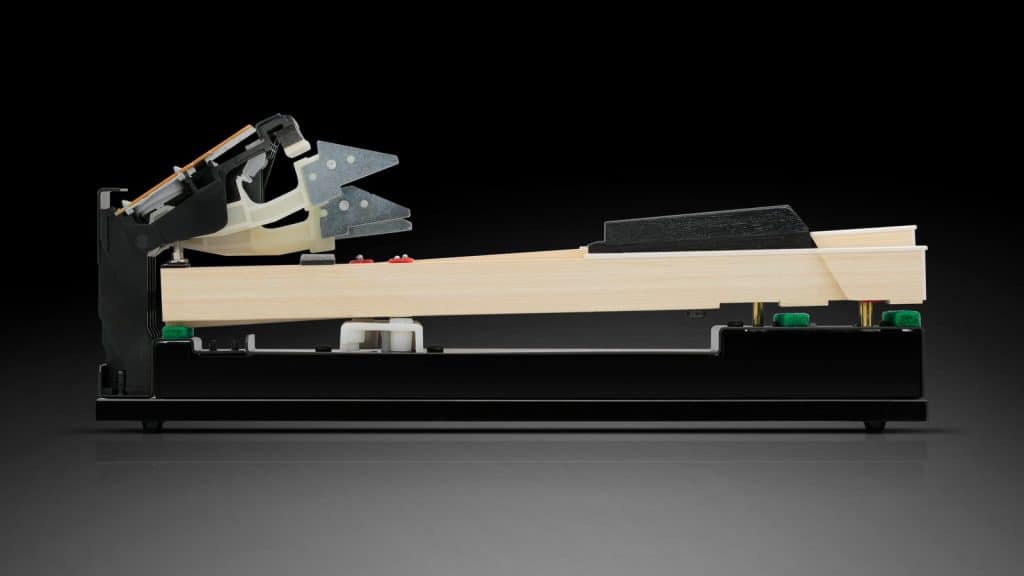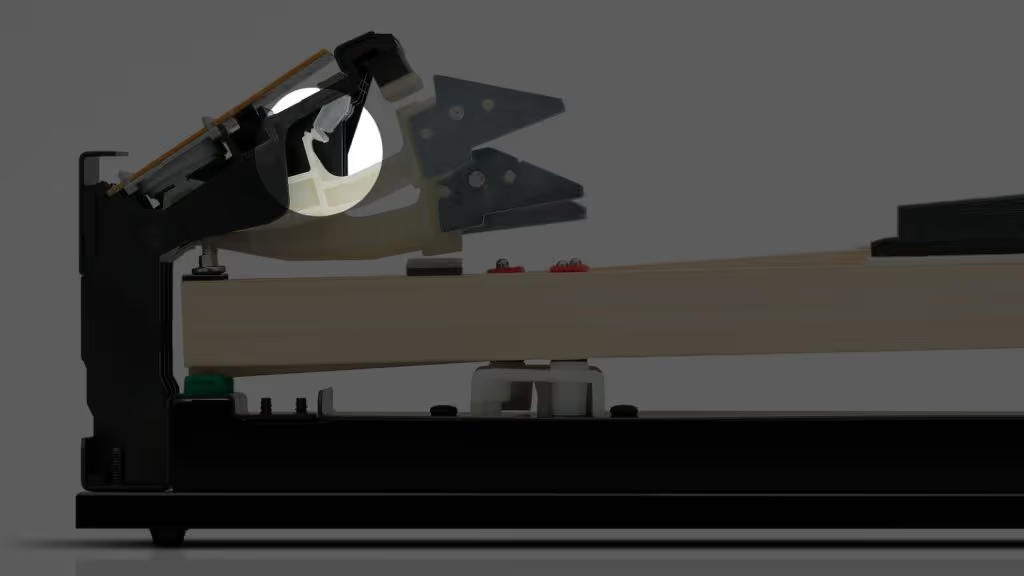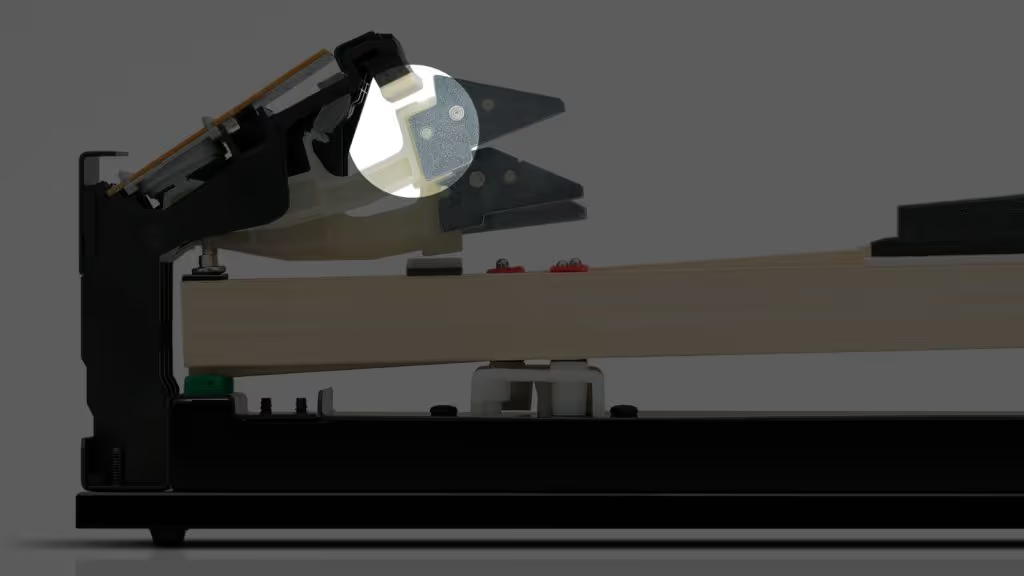A special feature of many mid-range and high-end digital pianos is the let-off simulation, which gives advanced pianists very precise control over their play.

A special feature of many mid-range and high-end digital pianos is the let-off simulation, which gives advanced pianists very precise control over their play.
Piano beginners will probably not even notice whether a digital piano keyboard is built with or without a let-off simulation. In fact, the mechanism – while intercepting the key travel – is not an “obstacle” that requires a great deal of effort to overcome. However, the escapement and its position allow the pianist to play finely controlled nuances, especially during quiet passages.

The word “simulation” already indicates that it replicates a detail of the action of an acoustic piano. This detail comes from the modern double-escapement repetition action, which evolved from the first double-escapement action invented by Sébastian Érard in the mid-19th century.
The double-escapement action is a complex decoupling of key and hammer. Simply put, it ensures that the hammer is ready to play immediately after a note is struck, even before the key has fully returned to its resting position. There are two ways to trigger the note:
This is also known as a repetition action.

The let-off point is particularly noticeable when playing pianissimo and wanting to apply as little force to the hammer movement as possible. It hence allows you to strike the keys in a controlled manner. Even a short keystroke is enough to send the hammer quickly but less forcefully to the virtual string.
Product descriptions and manuals sometimes use the term escapement (action/mechanism) instead of let-off simulation or mechanism.
On a digital piano, the let-off point is created by an inconspicuous mechanical device. Here, too, you must overcome a small resistance located further down the key travel. A tripple sensor system (3 sensors), which scans the key travel, is important for transmitting the velocity values for Note On- and Note Off-action:
Action 1: The key moves completely from sensor 1 to sensor 2 – the sound is triggered, and the velocity measurement determines how forcefully the key is struck.
Action 2: The key is not released completely but stops somewhere in the key travel. Now the note is struck again (repeated), and sensor 3 transmits the data for the new velocity measurement.
In principle, most headphones are suitable for use with digital pianos. Accordingly, there are no headphones that are explicitly labeled as "headphones for digital pianos". However, you should be aware of some technical subtleties, as ...
Kawai's ES Series portable pianos are popular with both beginners and advanced players, offering high-quality features in the €500-€1,600 price range. Key improvements over previous ES models include a significantly lighter weight, bass reflex speakers, ...
Wireless MIDI - just a few years ago, this wireless connection between musical instruments was as rare as it was expensive. Thanks to the growing popularity of Bluetooth as a means of communication, reasonably priced ...
Every year, Black Friday is one of the highlights of Cyber Week, with retailers offering digital pianos and keyboards at unbeatable prices. If you're still looking for your first instrument, this is your chance to ...
Modartt Pianoteq is a physical modeling instrument. All acoustic properties are generated synthetically, eliminating the need for gigabyte-heavy libraries. This offers significant advantages over conventional software pianos - especially in terms of flexibility, sonic variety, ...
In celebration of Earth Day, rhodesmusic.com is proud to announce the Rhodes MK8 Earth Edition, a limited edition of the electromagnetic piano in a special design. The special edition is limited to 50 units and ...
When you hear that a digital piano has wooden keys, you likely expect a realistic playing feel. But while many manufacturers advertise this as a quality feature, not all 'wooden' keyboards actually have real wooden ...
Acoustic or digital piano? With a Yamaha TransAcoustic Piano, you don't have to choose! This special hybrid piano technology combines the best of both worlds. Volume control on an acoustic piano - normally reserved for ...
Play the piano with iPad & iPhone - you have plenty of music apps to choose from! But which piano app for iOS devices offers you a good virtual piano? Here are our top piano ...
Which is the best digital piano for beginners? Most people don't want to spend too much money at first, but is an extremely cheap beginner's model suitable for learning the piano at all? For this ...
Digital pianos and mobile devices - a combination that has become increasingly important in recent years. Whether iPad & Co. or music computer - the USB MIDI/Audio function is the simplest and most reliable connection ...
Playing piano on a computer or mobile device can be convenient, but unfortunately, not all laptops, tablets, and smartphones can match the high audio quality of today's software pianos. For this reason, we recommend using ...
You are currently viewing a placeholder content from Facebook. To access the actual content, click the button below. Please note that doing so will share data with third-party providers.
More InformationYou are currently viewing a placeholder content from Instagram. To access the actual content, click the button below. Please note that doing so will share data with third-party providers.
More InformationYou are currently viewing a placeholder content from X. To access the actual content, click the button below. Please note that doing so will share data with third-party providers.
More Information